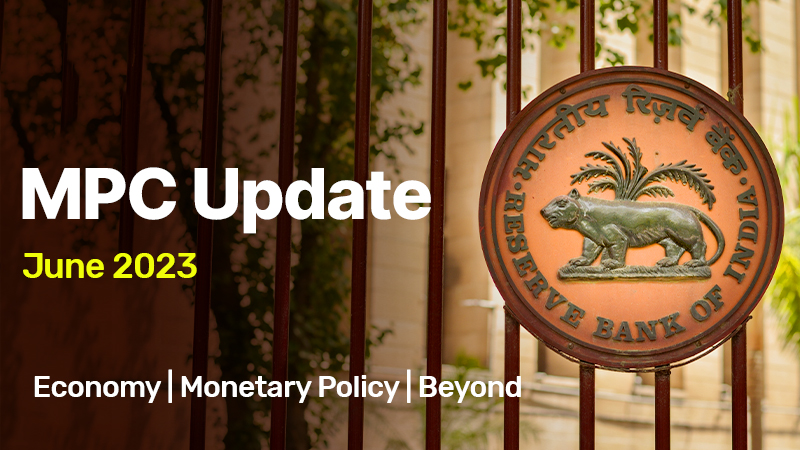
When No News is Good News
RBI Monetary Policy Committee Meeting Update
| Executive Summary Monetary Policy Committee
Fisdom Research Commentary
|
Key Announcements:
The Monetary Policy Committee (MPC) met on June 8, 2023, and made the following decisions based on their assessment of the current and evolving macroeconomic situation:
- The policy repo rate under the liquidity adjustment facility (LAF) will remain unchanged at 6.50 percent.
- The standing deposit facility (SDF) rate will also remain unchanged at 6.25 percent.
- The marginal standing facility (MSF) rate and the Bank Rate will be maintained at 6.75 percent.
The MPC’s focus will be on gradually withdrawing accommodation to ensure that inflation aligns with the medium-term target. The objective is to achieve a consumer price index (CPI) inflation rate of 4 percent within a band of +/- 2 percent while supporting economic growth.
Key developmental observations by the committee:
- India’s real GDP growth increased from 4.5% in Q3:2022-23 to 6.1% in Q4, supported by fixed investment and higher net exports.
- The real GDP growth for the fiscal year 2022-23 was 7.2%, higher than the previous estimate of 7.0%.
- In Q1:2023-24, domestic economic activity remained resilient with sustained expansion in manufacturing and services sectors.
- Urban spending showed robust growth, indicated by passenger vehicle sales and domestic air passenger traffic.
- Rural demand improved unevenly, with motorcycle sales expanding but tractor sales contracting due to unseasonal rains.
- Investment activity picked up, as seen in steel consumption and cement output expansion.
- CPI inflation decreased sharply to 4.7% in April 2023 from 6.4% in February, primarily due to favorable base effects.
- The average daily absorption under the LAF increased during April-May, and money supply and non-food bank credit expanded.
- India’s foreign exchange reserves stood at US$ 595.1 billion as of June 2, 2023.
Outlook by the committee
- Food price dynamics will shape the future inflation trajectory, with expected corrections in wheat prices but pressure on milk prices.
- The forecast of a normal monsoon is positive for agricultural production, but close monitoring is needed for spatial and temporal distribution.
- Crude oil prices have eased, but uncertainties remain.
- Input costs and output prices are expected to increase according to early survey results.
- CPI inflation is projected at 5.1% for 2023-24, with risks evenly balanced across quarters.
- Private consumption and economic activity are expected to be supported by higher crop production, normal monsoon, and buoyancy in services.
- Capital expenditure, moderation in commodity prices, and robust credit growth are expected to nurture investment activity.
- Weak external demand, geoeconomic fragmentation, and geopolitical tensions pose risks to the outlook.
- Real GDP growth for 2023-24 is projected at 6.5%, with risks evenly balanced across quarters.
- Inflation is expected to decline but will still be above the target, requiring continuous vigilance.
- The cumulative rate hike of 250 basis points by the MPC is transmitting through the economy and should contain inflationary pressures.
- Further monetary actions will be taken promptly and appropriately to anchor inflation expectations and bring down inflation to the target.
- The MPC remains focused on withdrawing accommodation while supporting growth.
Fisdom Research Commentary
The monetary policy committee’s decision and stance is in line with broad expectations. The absence of surprises is a healthy development. We expect the central bank to be cautious about indicating any reversal in the interest rate regime anytime soon. The expectation is for rates to plateau further for longer even as the central bank maintains a quasi-hawkish undertone on the subject of inflation. We expect the lag effect of rate decisions to be visible as changes continue transmitting and percolating through the upcoming quarter(s).
We continue to view yields offered by highly rated (Sov/AAA) securities in the four-to-six-year period as attractive. Longer term investors could initiate marginal allocation towards the longer end, i.e., 7+ years. The overall strengthening credit environment lends some confidence for highly aggressive fixed income investors to take marginal exposure to sub-AAA investment grade securities while maintaining duration towards the shorter end.















